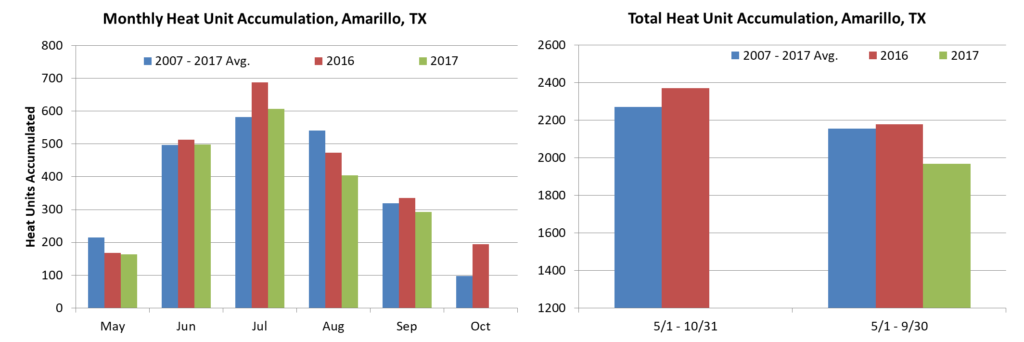by Seth Byrd – Extension Cotton Specialist, Lubbock, TX; Gaylon Morgan – State Extension Cotton Specialist, College Station, TX
The role of temperature, and specifically heat, in the growth and development of cotton is a common topic of discussion during the season. Heat units are a critical component for cotton’s growth and development; whether for germination and emergence, reproductive development, or fiber maturity and boll opening. In regards to maturing fiber and opening bolls, 900 – 1200 heat units are typically needed to go from a white flower to an open boll with mature fiber; however, actual requirements depend variety maturity, growth habit, fruiting position, and various environmental conditions.
Favorable conditions throughout the first half of the season in the northern High Plains led to high yield expectations. This was followed by cloudy and cool conditions for much of August and September, a period during which the majority of the harvestable boll load is still maturing. While a good goal would be to reach early October with 50 – 60% of the harvestable bolls open, for much of the region the crop is behind this mark and the forecast is not favoring a warm-up that would drastically benefit boll opening. Determining how to manage cotton in these conditions and get the most economical return out of the crop has now become a priority for many in the region.
How did We Get Here?
Much of this area experienced a rough start to the season with blowing sand and hail storms in May and June. Then rainfall in early July when most fields were beginning to square and again in August during peak bloom resulted in an excellent boll load and yield potential for the northern High Plains. Ultimately, rain and overall cool and cloudy weather during the critical boll and fiber development period decreased heat unit accumulation compared to the 10 year average (Figures 1 and 2). These conditions have resulted in a considerable proportion of the harvestable boll load to remain green and unopened in early October, traditionally a month where heat unit accumulation declines drastically.

Figure 1. Left – monthly heat unit accumulation and; right – total heat unit accumulation for May – October and May – September for Amarillo, TX averaged from 2007 – 2017, 2016, and 2017.

Figure 2. Left – monthly heat unit accumulation and; right – total heat unit accumulation for May – October and May – September for Lubbock, TX averaged from 2007 – 2017, 2016, and 2017.
Harvest-Aid Recommendations
Immature cotton and cool weather may make it tempting to apply harvest-aids, in particular boll openers, well before the crop has reached optimal timing for applications (60 – 75% open bolls or 4 nodes above cracked boll). However, early applications are unlikely to be the most efficient and cost effective way to maximize the number of harvestable bolls. According to this Cotton Physiology Today article, fiber development, while slow, will still occur down to temperatures in the mid-40’s. Even if ideal conditions occur intermittently, applying boll openers prematurely could result in opening bolls with immature fiber as well as bolls that are nearing maturity. It is important to note that there are no products, harvest-aids or otherwise, that will speed fiber maturation. Boll openers only weaken the sutures (the seams or creases between locs) on the bolls. Also, lint pounds per acre remains a priority over fiber quality; however, low micronaire cotton weighs less and can lead to substantial discounts. This means that a balance between fiber quality and yield should be a major factor when timing harvest-aid applications.
At this point in the season, the best option is to let the green bolls mature as much as possible throughout October and withhold applying harvest-aid products unless a hard freeze is predicted. Then, 4 -5 days prior to the first forecasted freeze, make an application of ethephon to loosen the sutures on the bolls. Under cool conditions, it is recommended that the highest label rate of ethephon be applied, approximately 42.5 oz/acre (6 lb. a.i. per gallon formulation). The inclusion of additional harvest-aid products can be based on the crop condition and if the yield potential validates the additional defoliant cost. This will give the crop the maximum amount of time to mature on it’s own with some timely assistance at the end of the season to open borderline mature bolls before they freeze closed.

Seth Byrd
Assistant Professor & Extension Specialist, Texas A&M AgriLife Extension Service
Lubbock, TX
806.746.6101
seth.byrd@tamu.edu